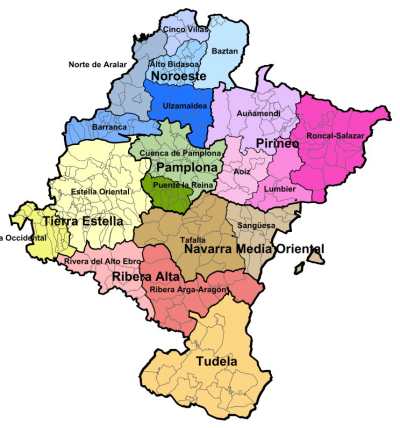Navarra: the autonomous community
Navarra was an independent kingdom for many centuries with its own parliament and laws
The Autonomous Community of Navarra borders with south western France to the North, the Basque Country to the West, La Rioja to the South and Aragón to the East. The region’s territory also includes the enclave of Petilla de Aragón, in the autonomous community of Aragón.

Navarra’s total area of 10,391 square kilometres makes it the eleventh largest of Spain’s 17 autonomous communities. It makes up 2.2% of total Spanish territory.
The latest population figure from the January 2006 census is 601,874, approximately one third of which lives in the capital, Pamplona-Iruña.
An independent kingdom for many centuries, Navarra was historically governed through a system of laws and institutions known as the ‘fueros’ – or the foral system - with its own parliament and system of laws. It retained its own institutions, except for the monarchy, when it was annexed by the Kingdom of Castile in the early sixteenth century.
It became a province of Spain in 1841, but, again, maintained institutions and legislation.
The single-province ‘Comunidad Foral de Navarra’, as it is officially known, was established in 1982 under the Law for the Reintegration and Improvement of the Régimen Foral, effectively bringing Navarra’s historic system of self-government up to date and extending the people’s right to it.
It recognised Spanish as the official language of the new autonomous community, with the Basque language also given official status in areas where it is spoken.
The first elections to the new regional parliament – known then as the Parlamento Foral - were held in 1979. The current President, Miguel Sanz Sesma, has led the region for the UPN Party – Unión del Pueblo Navarro – since 1996.
The party failed to achieve an absolute majority in the May 2007 election, and Miguel Sanz was forced to form a minority government after Socialist Party leadership in Madrid vetoed a proposed pact between the Navarra Socialists, Izquierda Unida, and the regionalist party, Nafarroa Bai.
The veto caused resignations across the board in the Navarra Young Socialists, as well as by the Socialist candidate for presidency of Navarra, Fernando Puras.
The Navarra Socialists followed party instructions in the second vote in the Navarra parliament in August 2007, presenting blank voting slips, and allowing Sanz to be elected as Regional President.
